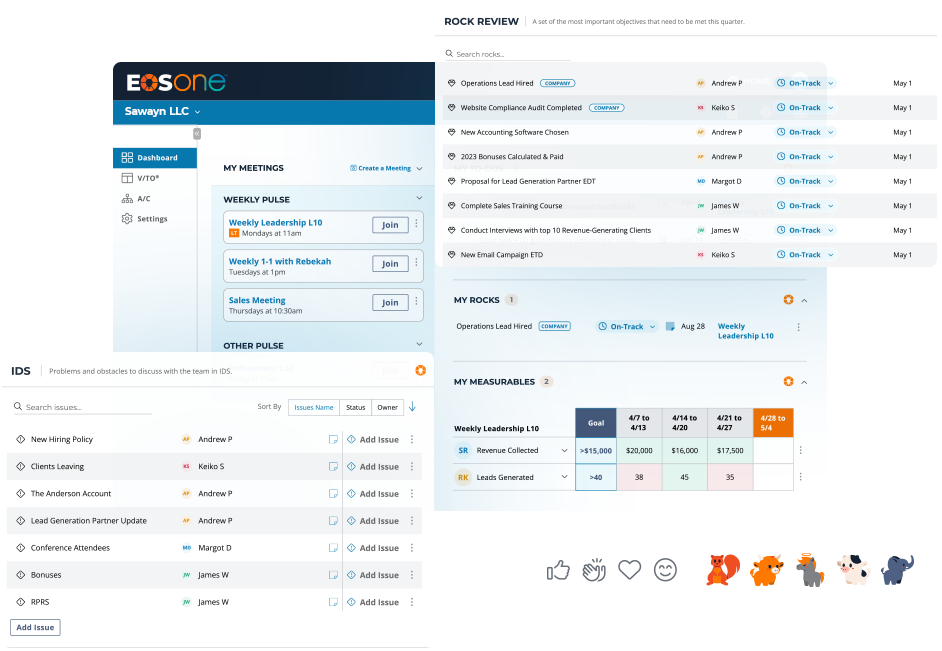When I led my own company before discovering EOS®, I thought having a vision meant setting revenue targets and growth goals. I had spreadsheets full of projections and a head full of ideas. But my team wasn’t aligned, meetings were unproductive, and despite working harder than ever, we weren’t making the progress we should have been.
Here’s what I’ve learned since then: Having goals isn’t the same as having vision. Goals tell you what you want to achieve. Vision shows you and your team how to get there.
The Hidden Cost of Unclear Vision
When your vision lacks clarity, it creates a series of problems that quietly undermine your company’s potential:
- Teams work hard but make little progress
- Meetings become circular discussions rather than decision-making sessions
- Different departments pursue conflicting priorities
- Good employees become frustrated and disengaged
- Leaders spend more time putting out fires than driving growth
But here’s what’s fascinating: The solution isn’t more planning. It’s better clarity.
What Real Vision Clarity Looks Like
True vision clarity isn’t just about having a destination in mind. It’s about having a complete picture that answers five critical questions:
- What are your Core Values? (The principles that guide every decision)
- What is your Core Focus™? (The reason your organization exists)
- What’s your 10-Year Target™? (The long-term goal that drives your team)
- How will you get there? (Your Marketing Strategy and proven process)
- What needs to happen now? (Your 3-Year Picture™ and 1-Year Plan)
When these elements align, something remarkable happens: decision-making becomes simpler, meetings become more productive, and teams naturally pull in the same direction.
The Three Levels of Vision Clarity
In implementing EOS® with hundreds of businesses, I’ve observed that vision clarity operates on three distinct levels:
- Individual Clarity: Leaders understand not just what they want, but why it matters
- Team Clarity: Every member knows their role in achieving the vision
- Execution Clarity: Daily actions clearly connect to long-term goals
Most businesses operate with only one of these levels—usually just individual clarity. The leader knows what they want. But without the other two levels, that knowledge stays trapped in their head, unable to drive real organizational change.
Making Vision Practical: A Simple Exercise
Here’s a practical exercise I use with my clients to begin building clarity. Take out a blank sheet of paper and write down:
- Three things your company does better than anyone else
- Three things holding your company back
- Three things that must be true in three years for you to feel successful
Now, compare your answers with those of your leadership team. The gaps between responses often reveal exactly where clarity is breaking down.
Common Pitfalls to Avoid
Through my work with Grand Rapids business leaders, I’ve seen several common mistakes in vision development:
- Making vision too complicated (Simple, clear direction beats comprehensive confusion)
- Setting it and forgetting it (Vision needs regular review and adjustment)
- Keeping it in your head (Documented vision beats perfect but unshared ideas)
From Clarity to Action
Once you have clarity, EOS® provides the tools to:
- Break down your vision into quarterly rocks (priorities)
- Create accountability through clear ownership
- Measure progress through scorecards and metrics
- Maintain alignment through regular, effective meetings
The Path Forward
Vision clarity isn’t something that happens by chance. It’s the result of a deliberate process—one that transforms good intentions into measurable results. When organizations achieve true clarity at all three levels (Individual, Team, and Execution), the impact is profound:
- Decision-making becomes streamlined
- Team alignment happens naturally
- Resources get allocated more effectively
- Progress becomes measurable and predictable
The beauty of the EOS® approach to vision is that it’s both comprehensive and practical. It gives organizations the tools they need to not just articulate their vision, but to make it real through consistent, focused action.
Remember: Clarity isn’t just about seeing where you’re going—it’s about ensuring everyone else sees it too. When your entire team shares the same clear vision, execution becomes more focused, decisions become simpler, and results follow naturally.
Don’t let another quarter pass with your team pulling in different directions. The path to clarity is available, proven, and ready to transform your organization. With the right tools and approach, your team can move from confusion to clarity, from frustration to focused action, and from stalled growth to sustained success.

